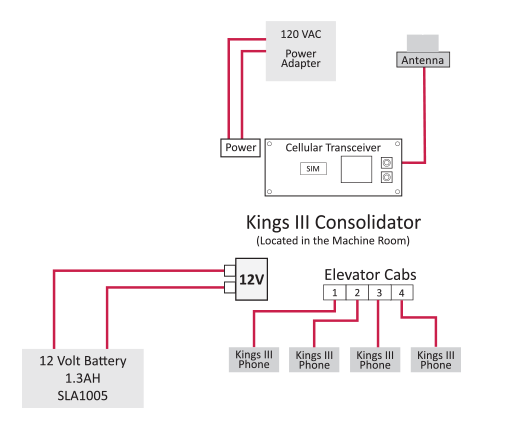Skyline Cellular Elevator Emergency Phone Solution
A trend in the communications space is the elimination of analog telephone lines, or plain old telephone service (POTS). Here’s the breakdown of what you need to know during this transition and information on Kings III’s cellular emergency call box solution.
What to Know About Cellular Phone Lines for Your Emergency Devices
While analog line elimination has been an ongoing conversation for some time, there has been much in the news in the last year of telecom giants supporting legislation that would eliminate a requirement for the telco to offer landline voice service. What does that mean for those in the building owner and manager space when the industry is already moving on its own to VoIP and cellular emergency call box solutions? For those not already future-proofing your communication systems, now is the time to do so.
What’s your phone line replacement strategy? “Now, there is little the FCC can do to protect consumers when companies decide to retire their copper infrastructure. When this happens it means that people who rely on copper lines to monitor their health, protect their schools and homes, and participate in society are not protected from a downgrade in quality of service in these essential communications.” – Source
The FCC order doesn’t draw a clear picture of when providers will decommission your analog lines, just that they have the permission to do so. Do you have a plan in place for when this happens?
Whether you’re relying on a dedicated phone line or moving towards a cellular emergency call box, it’s essential to be prepared for these updates, especially for critical systems like emergency elevator phone lines.
Go Cellular: Incorporating Your Emergency Phone Lines in Your Future Proofing Process
Emergency phone lines, such as the dedicated phone lines used in each of your elevator cabs, are not always prioritized in this elimination.
VoIP can be problematic for elevator emergency phone service due to specific code requirements, including 24/7 monitoring and the ability of the monitoring party to call back into the cab if a disconnection occurs. 24/7 monitoring will often mean you have a third party involved and if on VoIP, that third party may need to have access to your network—something your IT team may not be entirely comfortable with. Beyond internal concerns, relying on internet service during emergencies is not recommended. For this reason, cellular emergency phone lines can provide a reliable alternative to landlines, avoiding the pitfalls of network dependence. Learn more: How VoIP Works (Or Doesn’t Work) with Your Elevator Emergency Phone Service.
That doesn’t mean there’s no solution. While landline service is reliable, it’s not the only answer—and it’s far from perfect, especially when it comes to connection speed in emergencies.
More about the basics of VoIP vs. landlines and other phone line information >>
The Natural Emergency Phone Solution: Kings III Skyline Cellular Service
Cellular is the viable solution. Here’s how to customize cellular for emergency use:
- For ASME code compliance, ensure your solutions allow the monitoring party to identify the caller’s location, including the elevator cab number, without assistance from the caller.
- You should have a dedicated phone line for power and a battery backup with sufficient standby and talk time to ensure functionality during power outages.
- Consider connection time in your evaluation, focusing on both the technology for placing the call and the capacity of the monitoring center to quickly respond. This includes factors like overwhelmed elevator call box centers or 911. Speed is essential in emergencies for both life safety and the tenant experience. A fast, reliable response—like those offered by Kings III elevator monitoring—enhances your property’s concierge-level service, ensuring top-tier emergency response.
How exactly does Kings III Skyline cellular service work?

- Skyline completely eliminates dependency on POTS lines by leveraging the mobile network. It is effectively a cellular POTS line replacement.
- For elevators, our two piece solution uses a traditional ADA compliant handsfree elevator phone box inside the cab, with the cellular transceiver located outside of the concrete and steel-lined shaft in order to secure the best possible signal for the elevator cellular line.
- Typically, our Skyline emergency phone unit is placed in a telecom room, but it can be remotely positioned elsewhere to achieve a better signal, as long as a power outlet is available for the emergency cellular phone.
- Our Skyline solutions utilize existing wiring running between the telecom room to machine room. Then existing wiring is run from the machine room, through travel cable, into the elevator cab. Important to note: We are often asked, “Is Skyline wireless?” While the signal enters the building in a “wireless” fashion, there is copper wiring required to connect the dial tone all the way to the elevator cab. This is probably the most common misconception we deal with.
Some common cellular emergency phone Q&A’s:
- Do elevators need a phone line?
Yes. Even with an elevator cellular dialer, while the signal enters the building in a "wireless" fashion, there is copper wiring required to connect the dial tone all the way back to the elevator cab. However, Skyline cellular completely eliminates dependency on POTS lines (Plain Old Telephone Service) by leveraging the mobile network.
- Does an elevator need a dedicated cellular phone line?
Elevators do require a dedicated phone line for communication, and Kings III’s Skyline Cellular Solution offers cost-saving alternatives by working around the need for a traditional dedicated cellular phone line. For emergency phones to function, they must have priority access to a two-way communication path, whether through a traditional phone line or a cellular emergency call box. This does not always require a dedicated communication path. If an emergency phone shares its line with other devices, smart consolidation technology is needed to ensure multiple phones can operate simultaneously. Kings III partners with multiple carriers, often at lower costs, and provides a turnkey solution—including hardware and cellular signal access—eliminating the need for clients to sign up for additional wireless service.
- What are POTS lines used for?
POTS (Plain Old Telephone Service) lines rely on traditional analog phone services with old-fashioned copper wires to provide power and connectivity to the telephone service provider's central switching system. While still effective, this method is becoming outdated as more modern solutions, such as the cellular dialer for elevator phones, offer greater flexibility and efficiency for emergency communication needs.
- Is wiring required for a cellular elevator phone?
Yes, while we often think of cellular and wireless as interchangeable, that is not the case for emergency phones. While the signal enters the building in a “wireless” fashion, there is copper wiring required to connect the dial tone all the way to the elevator phone line in the cab, ensuring reliable communication during emergencies.
- Will customers be responsible for providing the cellular line?
No. Kings III provides cellular signals. We have agreements with multiple carriers, eliminating your need to deal with someone else for elevator phone line service—often at a lower cost than you would find if you were to buy the line yourself. This is a turnkey solution where we provide the hardware and access to the cellular signal, no need for the client to go sign up with a wireless carrier for another monthly bill.
- Is cellular service reliable?
Because our business is focused on life safety, we recognize the importance of having a signal. We test coverage before installation and can also remotely locate the cellular emergency call box transceiver away from the phone (if necessary) to achieve the best signal strength.
- How can I test my cellular phone for elevators?
In order to test your elevator cellular solution, you must make sure that it passes all code requirements. See more on testing your elevator phone here.
- How often should elevator phones be tested?
We recommend testing your elevator phones at least once a month. Kings III's all-inclusive service includes auto testing, which performs testing monthly.See more on testing your elevator phone here.
- Are cellular phones required in elevators?
You can use either a traditional solution (landline or POTS plain old telephone service) or a cellular emergency call box for your elevator phones. Reach out to one of our experts to help you determine what makes the most sense to your property.
- Can your Skyline Cellular solution replace my AT&T elevator phone line?
Yes. Our cellular solution can be used in place of AT&T elevator phone service, Verizon elevator phone service, and any other carrier service.








